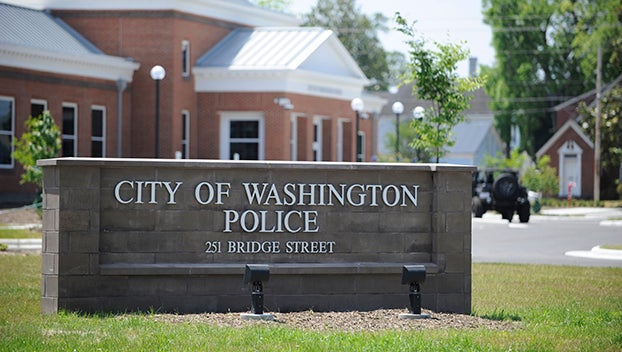POLLINATORS: Beneficial insects vital to spring gardening
Published 7:01 pm Thursday, February 11, 2016

FILE PHOTO | DAILY NEWS
POLLINATOR HAVEN: Cypress Landing’s butterfly garden, constructed in 2012, was part of a mission to beautify the neighborhood and attract butterflies and other pollinators, which are vital to the process that ensures a gardener’s fruits of labor. Pollinators facilitate production of many fruits and vegetables. Eighty percent of all flowering plants require animal pollinators, and one out of every three bites of food eaten each day result from their role.
Several years ago, a project was started at Cypress Landing Golf Course for everyone to enjoy, not just the residents of the neighborhood. An oak tree that caused shade on the golf course at Cypress Landing was taken down and a group of residents decided the space left could be used to implement a community butterfly garden.
The group, led by Beaufort County Cooperative Extension Master Gardener Judy Keohane and Cypress Landing resident Stan Cohen, built the garden, focusing on plants that would attract butterflies, per Keohane’s instruction and expertise, according to Cohen. Through the garden and another, previous project, the golf course became the 23rd in North Carolina to become Audubon certified and has continued that certification, Cohen said.

FILE PHOTO | DAILY NEWS
COMMON BUCKEYE: A Common Buckeye feeds on lantana blooms in the Cypress Landing Community Butterfly Garden. Though flowering plants require animal pollination to reproduce, vegetable and fruit plants would not bear any produce if not for pollinators.
“The whole purpose was to have something for the community,” Cohen said.
The effects of creating an environment, such as the butterfly garden at Cypress Landing, are vital to the pollination process for flora in spring, according to Gene Fox, consumer horticulture specialist at the extension agency.
Fox said butterflies and other insects such as bumblebees, honeybees and wasps, as well as humming birds, are pollinators, giving various plants the ability to produce fruit and vegetables and flowering plants the ability to reproduce.
Pollinators, particularly butterflies, are attracted by colorful flowering plants such lantana, cloudless sulphur, ginger lily and orange zinnias. Eighty percent of all flowering plants require animal pollinators and an estimated one out of every three bites of food eaten each day result from the work of pollinators, according to a Power Point presentation by North Carolina State University’s College of Agriculture and Life Sciences.
The presentation also points out that $18.9 billion worth of crops in the United States depend on pollination.
“They pollinate,” Fox said. “The other side of that is it’s very aesthetically pleasing. Red, orange and purple flowers attract (butterflies). There are quite a few plants that only get pollinated by butterflies. Almost everything you put out there has to be pollinated to make fruits and vegetables.”
But Fox says homeowners sometimes make the mistake of warding off or, in many cases, killing pollinators through application of insecticides, an action that could be detrimental to spring vegetable gardens, orchards, flower gardens and other plants.
“We try to educate homeowners on being careful when using insecticides,” Fox said. “They have a residual effect, and you won’t have any insects and flowers.”
Dan Bergbauer, a master gardener at the extension agency, said in his experience, however, he doesn’t view butterflies and pollinators as one in the same, per se. Although pollinators, including butterflies, do, in fact, facilitate the reproduction of flowering plants and production of vegetables and fruits from plants such as cucumbers, squash, blueberries, apples and many others, butterflies lay eggs, that, in turn, produce caterpillars that eat vegetables, flowers and other vegetation, Bergbauer said.

FILE PHOTO | DAILY NEWS
FAVORITE COLOR: A Cloudless Sulphur feeds on a red flowering plants. Butterflies are attracted to red, purple, orange and yellow blooms, making the presence of such flowering plants essential in attracting pollinators such as butterflies.
“I have a problem because they come from caterpillar form,” Bergbauer said. “They like to eat green things when they get into your vegetables. They are a non-beneficial insect. They can destroy a lot. So I try not to be too friendly with butterflies from that standpoint. They can destroy some of the vegetable plants because they forage in the caterpillar stage. But without pollinators, there would be huge losses in vegetable and fruit crops.”
Though butterflies, in caterpillar form, are a detriment to vegetation in some cases, butterflies and other pollinators are vital to the existence of flowers, vegetables and fruits that put food on tables. Application of insecticides can put balance in the equation, but the wrong timing or too much of a chemical could ruin the entire process of pollination by some of these insects so it’s important to have a good basis of knowledge when applying chemicals to protect one’s garden.
For more information on the application of insecticides or the types of flowers that attract butterflies and other pollinators, call the Beaufort County Cooperative Extension at 252-946-0111.

FILE PHOTO | DAILY NEWS
PAINTED LADY: A Painted Lady rests on a Lantana bush in the Cypress Landing Community Butterfly Garden.





